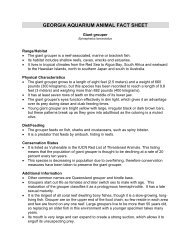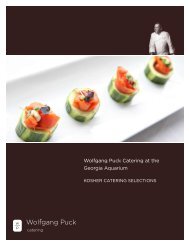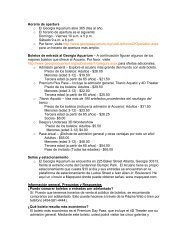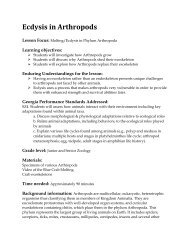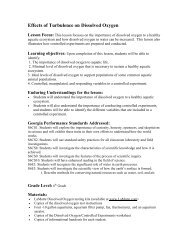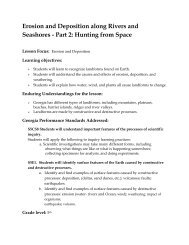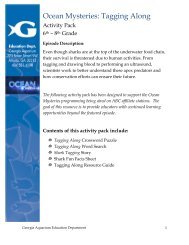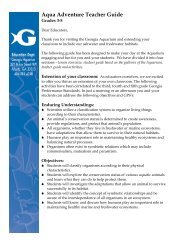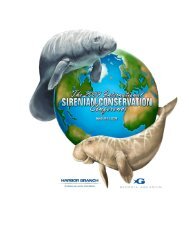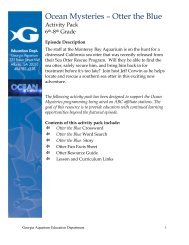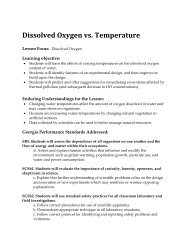What is the Story with Sand? - Georgia Aquarium
What is the Story with Sand? - Georgia Aquarium
What is the Story with Sand? - Georgia Aquarium
Create successful ePaper yourself
Turn your PDF publications into a flip-book with our unique Google optimized e-Paper software.
<strong>What</strong>’s <strong>the</strong> <strong>Story</strong> <strong>with</strong> <strong>Sand</strong><br />
Lesson Focus: <strong>Sand</strong><br />
Learning Objectives:<br />
• Students will understand that sand <strong>is</strong> <strong>the</strong> result of wea<strong>the</strong>ring of rocks.<br />
• Students will recognize that different types of sand ex<strong>is</strong>t.<br />
• Students will differentiate between sand, soil, and o<strong>the</strong>r small particles.<br />
Enduring Understandings for <strong>the</strong> Lesson:<br />
• Erosion and wea<strong>the</strong>ring of mountain rocks creates sand which <strong>is</strong> <strong>the</strong> building<br />
blocks of our beaches.<br />
• Our beaches reflect what our rivers are carrying and human activities can lead to<br />
greater sediment loads in our rivers.<br />
<strong>Georgia</strong> Performance Standards Addressed:<br />
S5-6CS1. Students will be aware of <strong>the</strong> importance of curiosity, honesty, openness,<br />
and skeptic<strong>is</strong>m in science and will exhibit <strong>the</strong>se traits in <strong>the</strong>ir own efforts to<br />
understand how <strong>the</strong> world works.<br />
a. Keep records of investigations and observations and do not alter <strong>the</strong><br />
records later.<br />
b. Carefully d<strong>is</strong>tingu<strong>is</strong>h observations from ideas and speculation about those<br />
observations.<br />
c. Offer reasons for findings and consider reasons suggested by o<strong>the</strong>rs.<br />
S5-6CS3. Students will use tools and instruments for observing, measuring, and<br />
manipulating objects in scientific activities.<br />
d. Identify and practice accepted safety procedures in manipulating science<br />
materials and equipment.<br />
S5-6CS5. Students will communicate scientific ideas and activities clearly.<br />
b. Make sketches to aid in explaining scientific procedures or ideas.<br />
S5-6CS4. Students will use ideas of system, model, change, and scale in exploring<br />
scientific and technological matters.<br />
a. Observe and describe how parts influence one ano<strong>the</strong>r in things <strong>with</strong> many<br />
parts.<br />
S5E1. Students will identify surface features of <strong>the</strong> Earth caused by constructive and<br />
destructive processes.<br />
a. Identify surface features caused by constructive processes.
• Deposition (deltas, sand dunes, etc.)<br />
b. Identify and find examples of surface features caused by destructive<br />
processes.<br />
• Erosion (water—rivers and Ocean, wind)<br />
• Wea<strong>the</strong>ring<br />
c. Relate <strong>the</strong> role of technology and human intervention in <strong>the</strong> control of<br />
constructive and destructive processes. Examples include, but are not<br />
limited to<br />
• Flood control, (dams, levees, storm drain management, etc.)<br />
• Beach reclamation (<strong>Georgia</strong> coastal <strong>is</strong>lands)<br />
S6E5. Students will investigate <strong>the</strong> scientific view of how <strong>the</strong> earth’s surface <strong>is</strong><br />
formed.<br />
b. Investigate <strong>the</strong> contribution of minerals to rock composition.<br />
d. Describe processes that change rocks and <strong>the</strong> surface of <strong>the</strong> earth.<br />
h. Describe soil as cons<strong>is</strong>ting of wea<strong>the</strong>red rocks and decomposed organic<br />
material.<br />
i. Explain <strong>the</strong> effects of human activity on <strong>the</strong> erosion of <strong>the</strong> earth’s surface.<br />
Grade Level: 5 th – 6 th<br />
Materials:<br />
• <strong>Sand</strong> samples from various beaches/rivers<br />
• Soil samples – from a variety of places<br />
• Hand lenses or Microscopes (If using microscopes, stereo microscopes are<br />
preferable but if using biological microscopes, use only <strong>the</strong> 4X magnification.)<br />
• Black and white paper<br />
• Colored pencils<br />
• Metric rulers<br />
• Magnets<br />
• Vinegar or o<strong>the</strong>r weak acid<br />
Time Needed: one to two 45-minute periods<br />
Background information:<br />
Wea<strong>the</strong>ring causes <strong>the</strong> splitting of rock into smaller pieces. There are three main types<br />
of wea<strong>the</strong>ring: physical, chemical and biological. Physical wea<strong>the</strong>ring does not affect<br />
<strong>the</strong> chemical makeup of <strong>the</strong> rock and it just changes <strong>the</strong> size of pieces. It can be caused<br />
by tumbling of rocks (such as in a river) or by <strong>the</strong> freeze/thaw cycle of water. Chemical<br />
wea<strong>the</strong>ring <strong>is</strong> caused by a chemical reaction between rocks and water (or water<br />
solutions) or gases in <strong>the</strong> air. Water (especially when acidic) can d<strong>is</strong>solve certain<br />
minerals such as calcite, limestone or marble. Oxygen in <strong>the</strong> air reacts <strong>with</strong> iron- or
manganese-containing elements and causes <strong>the</strong> formation of iron oxides which are <strong>the</strong><br />
red pigments in <strong>Georgia</strong>’s red clay. (Th<strong>is</strong> process <strong>is</strong> commonly known as “rusting.”)<br />
Ano<strong>the</strong>r chemical reaction – hydrolys<strong>is</strong> - causes wea<strong>the</strong>ring of silicate minerals to form<br />
clays. Biological wea<strong>the</strong>ring can be caused by plant roots growing into rock, by<br />
chemicals excreted by certain living organ<strong>is</strong>ms such as lichen, or by animals (including<br />
humans).<br />
As rock <strong>is</strong> wea<strong>the</strong>red, it breaks up into smaller and smaller pieces. Those pieces that<br />
survive as small rocks we call sand. The type of sand found in a river and on <strong>the</strong> beach<br />
varies from one to ano<strong>the</strong>r based on whatever type of rock <strong>is</strong> common upstream.<br />
However, on some beaches, not all sand <strong>is</strong> deposited from rivers. Some of <strong>the</strong> “sand” <strong>is</strong><br />
made up of tiny bits of coral, small shells or shell fragments caused by wave action on<br />
coral reefs. <strong>Sand</strong> found on a beach <strong>with</strong> lots of wave action will have more rounded<br />
and smooth grains of sand, whereas a more protected beach will have more angular<br />
and sharp grains.<br />
For sand made from rocks, <strong>the</strong> color of <strong>the</strong> sand <strong>is</strong> related to whatever minerals are<br />
contained in <strong>the</strong> sand. <strong>Sand</strong> made of quartz will create a shiny white beach. <strong>Sand</strong><br />
containing lots of feldspar will make a beach more orange colored. Black beaches are<br />
formed by sand derived from rocks that contain minerals such as mica and hornblende.<br />
If sand has magnetic properties, <strong>the</strong>n it contains <strong>the</strong> mineral magnetite. <strong>Sand</strong> <strong>is</strong> defined<br />
according to specific parameters. If more than 50% of <strong>the</strong> material <strong>is</strong> bigger than 75<br />
microns (0.075 mm) and smaller than 4.75 mm in diameter, it <strong>is</strong> considered sand. If <strong>the</strong><br />
average particle size <strong>is</strong> smaller, it <strong>is</strong> actually considered silt or clay and if <strong>the</strong> average<br />
particle size <strong>is</strong> larger, it <strong>is</strong> considered gravel.<br />
Learning Procedure:<br />
1. Start <strong>the</strong> d<strong>is</strong>cussion by reviewing what <strong>the</strong> students already know about<br />
wea<strong>the</strong>ring and erosion. (Th<strong>is</strong> lesson should occur after <strong>the</strong>y have learned <strong>the</strong>se<br />
concepts and will help reinforce <strong>the</strong>m.)<br />
2. L<strong>is</strong>t on a poster questions students have about sand. Here are a few to consider<br />
if <strong>the</strong>y don’t mention <strong>the</strong>m: Where does sand come from <strong>What</strong> story does <strong>the</strong><br />
sand tell you Why <strong>is</strong> most sand white or beige Why are some beaches black<br />
<strong>What</strong> else can beaches be made of besides sand – or what else can “sand” be<br />
made of How big or little can a particle be and still be considered sand<br />
3. Introduce different samples of sand and identify where <strong>the</strong>y originate. . Explain<br />
to <strong>the</strong> students some of <strong>the</strong> things <strong>the</strong>y can look for when investigating sand and<br />
give <strong>the</strong>m Student Worksheet to fill out as <strong>the</strong>y investigate six known samples.<br />
4. Tell <strong>the</strong> students we have some mystery sand that has been sent to <strong>the</strong> classroom.<br />
There <strong>is</strong> no return address so we have no idea where it originated so we need to<br />
investigate tit’s composition to determine its origin. .<br />
5. Have <strong>the</strong> students work through <strong>the</strong> student worksheet using <strong>the</strong>black and white<br />
paper and <strong>the</strong> light source to see better. Have a d<strong>is</strong>cussion on what <strong>the</strong> answers
are to <strong>the</strong> two mystery samples and <strong>the</strong>n recap <strong>the</strong> answers to <strong>the</strong> questions in<br />
#2.<br />
Evaluation:<br />
1. From samples of rock or minerals, have students identify which rock/rocks <strong>the</strong>ir<br />
sand could have originated. .<br />
Extensions:<br />
1. Have students write a story from <strong>the</strong> sand’s point of view from beginning to end.<br />
Th<strong>is</strong> could allow <strong>the</strong> teacher to evaluate <strong>the</strong>ir knowledge of wea<strong>the</strong>ring and even<br />
<strong>the</strong> rock cycle.<br />
2. Ask <strong>the</strong> students to investigate <strong>the</strong> process of dune-building and how big desert<br />
dunes come to be where <strong>the</strong>y are and how <strong>the</strong>y form and change over time.<br />
3. Some beaches seem dirty. If th<strong>is</strong> <strong>is</strong> <strong>the</strong> case, where does that dirt originate. <br />
<strong>What</strong> would th<strong>is</strong> tell you about <strong>the</strong> watershed from which th<strong>is</strong> sand <strong>is</strong> being<br />
deposited<br />
4. Have students brainstorm ways that beaches get “altered” by humans including,<br />
but not limited to, damming up rivers, beach reclamation and refurb<strong>is</strong>hing,<br />
building on <strong>the</strong> very edge of <strong>the</strong> Ocean, building seawalls, breakwaters and<br />
groins to prevent erosion, etc. Have <strong>the</strong>m research a topic of <strong>the</strong>ir choosing.<br />
Resources:<br />
Microscopy Society of America -- a source to order sand samples from:<br />
http://www.microscopy.org/education/ProjectMICRO/<strong>Sand</strong>L<strong>is</strong>t.cfm<br />
Microbus – Take a Microscope Trip -- information and lessons for using microscopes<br />
<strong>with</strong> a nice d<strong>is</strong>cussion about sand:<br />
http://www.microscope-microscope.org/applications/sand/microscopic-sand.htm<br />
Coastal Regions and Small Island Papers: An Introduction to <strong>Sand</strong> Watch: An Educational<br />
Tool for Sustainable Development – an online article about sand<br />
http://www.unesco.org/csi/pub/papers3/sande7.htm<br />
Lesson developed by: Sarah Topper, Greenfield Hebrew Academy<br />
Th<strong>is</strong> activity <strong>is</strong> a product of <strong>the</strong> Rivers to Reef Educators Workshop sponsored by <strong>the</strong> <strong>Georgia</strong><br />
<strong>Aquarium</strong> and Gray’s Reef National Marine Sanctuary in which <strong>the</strong> author was a participant.<br />
For more information about th<strong>is</strong> workshop, <strong>Georgia</strong> <strong>Aquarium</strong>, or NOAA Gray’s Reef National<br />
Marine Sanctuary, please v<strong>is</strong>it our websites at www.georgiaaquarium.org or<br />
http://graysreef.noaa.gov/
<strong>What</strong>’s <strong>the</strong> <strong>Story</strong> <strong>with</strong> <strong>Sand</strong><br />
Student Worksheet<br />
Name: ________________<br />
Directions: Collect some of each of <strong>the</strong> six samples of sand. Write an answer for<br />
each step (#1-11) in Data Table #1 below.<br />
1. Record <strong>the</strong> source of each of your samples.<br />
2. <strong>What</strong> <strong>is</strong> <strong>the</strong> general color of <strong>the</strong> sample (before magnification)<br />
3. Looking at your samples of sand under <strong>the</strong> microscope (at 4X magnification<br />
only), place a metric ruler in <strong>the</strong> view to get a sense of <strong>the</strong> size of grains. <strong>What</strong> <strong>is</strong><br />
<strong>the</strong> size of <strong>the</strong> grains<br />
4. Are <strong>the</strong> sample grains all about <strong>the</strong> same size or very different sizes<br />
5. <strong>What</strong> shapes do you see Sketch a few if you can’t describe <strong>the</strong>m well.<br />
6. Are <strong>the</strong> grains rough or smooth<br />
7. <strong>What</strong> colors are <strong>the</strong> grains Use your white or black paper to help you see <strong>the</strong><br />
color of <strong>the</strong> sand better.<br />
8. Sketch <strong>the</strong> magnified view of <strong>the</strong> sand using color pencils.<br />
9. Try using a magnet on <strong>the</strong> sand to see if it picks anything up.<br />
10. Try putting a few grains of sand in a small cup and adding a few drops of<br />
vinegar. If it <strong>is</strong> bubbling, that <strong>is</strong> considered a reaction. A reaction indicates <strong>the</strong><br />
presence of calcite in rocks or carbonate in shells.<br />
11. Decide whe<strong>the</strong>r based on all <strong>the</strong> evidence, if you have sand made from rocks or<br />
sand made from shells.<br />
Data Table #1<br />
Sample 1 2 3 4 5 6<br />
1. Source of<br />
Sample<br />
2. General<br />
Color before<br />
magnification<br />
3. Size of<br />
Grains (mm)<br />
4. Grains all<br />
same size or<br />
different sizes
5. <strong>What</strong><br />
shapes<br />
6. Rough or<br />
smooth<br />
7. Color(s)<br />
8. Sketch<br />
9. Magnetic<br />
10. React <strong>with</strong><br />
acid<br />
11. Rocks or<br />
Shells<br />
Now, collect 2 of <strong>the</strong> mystery samples and examine <strong>the</strong>m using <strong>the</strong> 11 steps above.<br />
Guess which of <strong>the</strong> six locations <strong>the</strong>y came from by your observations.<br />
Data Table #2<br />
Sample Mystery <strong>Sand</strong> 1 Mystery <strong>Sand</strong> 2<br />
2. General Color<br />
before<br />
magnification<br />
3. Size of Grains<br />
(mm)<br />
4. Grains all<br />
same size or<br />
different sizes<br />
5. <strong>What</strong> shapes<br />
6. Rough or
smooth<br />
7. Color(s)<br />
8. Sketch<br />
9. Magnetic<br />
10. React <strong>with</strong><br />
acid<br />
11. Rocks or<br />
Shells<br />
1. Source of<br />
Sample<br />
Questions<br />
1. <strong>What</strong> are some things that <strong>the</strong> color of <strong>the</strong> sand could tell you<br />
2. When <strong>the</strong> sand <strong>is</strong> smooth vs. rough, what can that tell you about <strong>the</strong> conditions on<br />
that beach<br />
3. <strong>What</strong> mineral would cause <strong>the</strong> sand to be magnetic<br />
4. <strong>What</strong> <strong>is</strong> <strong>the</strong> range of sizes you found for sand
5. <strong>What</strong> do you think determines <strong>the</strong> minerals/rocks that are most likely to become<br />
sand<br />
6. Predict what would happen to beaches when people dam up rivers



